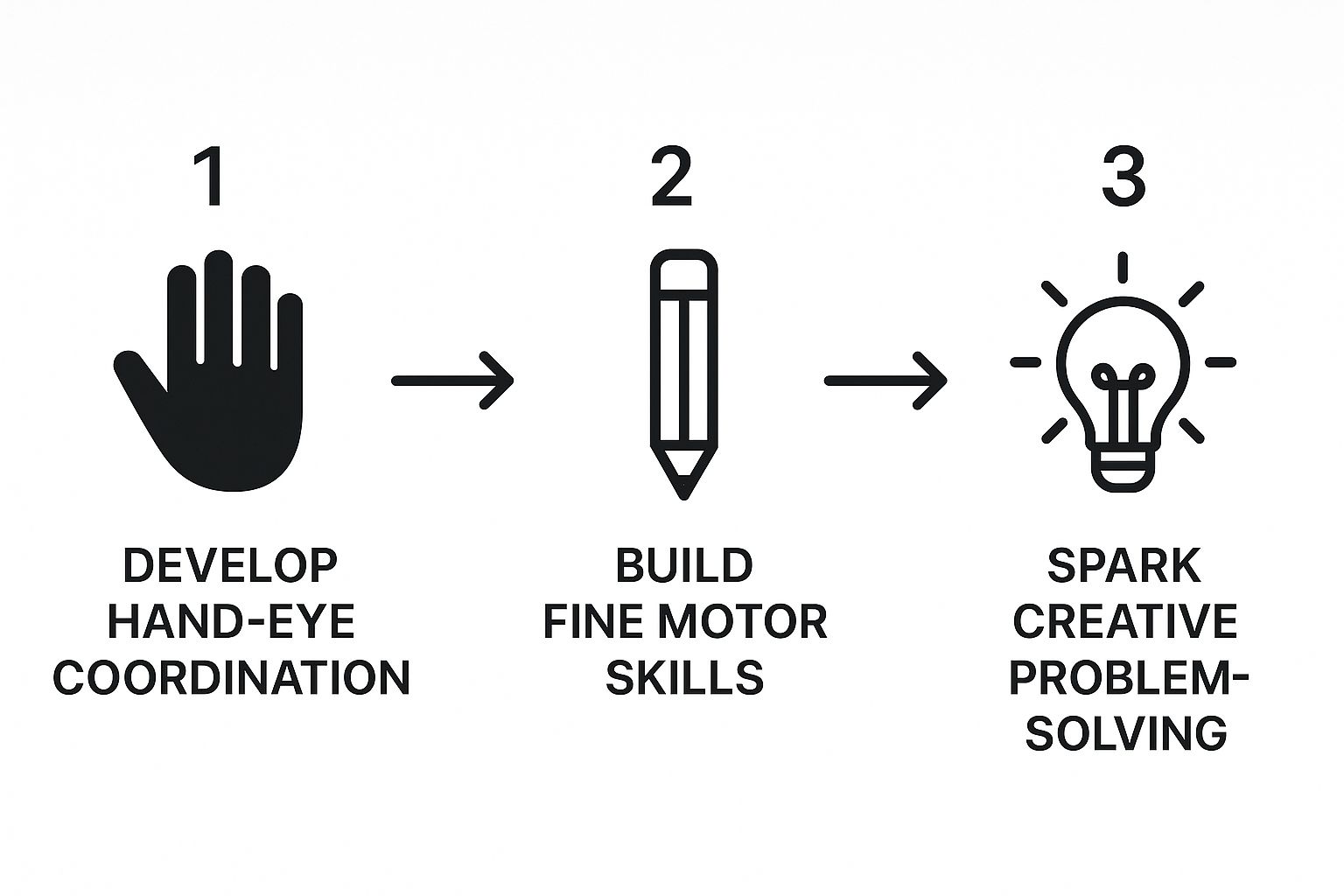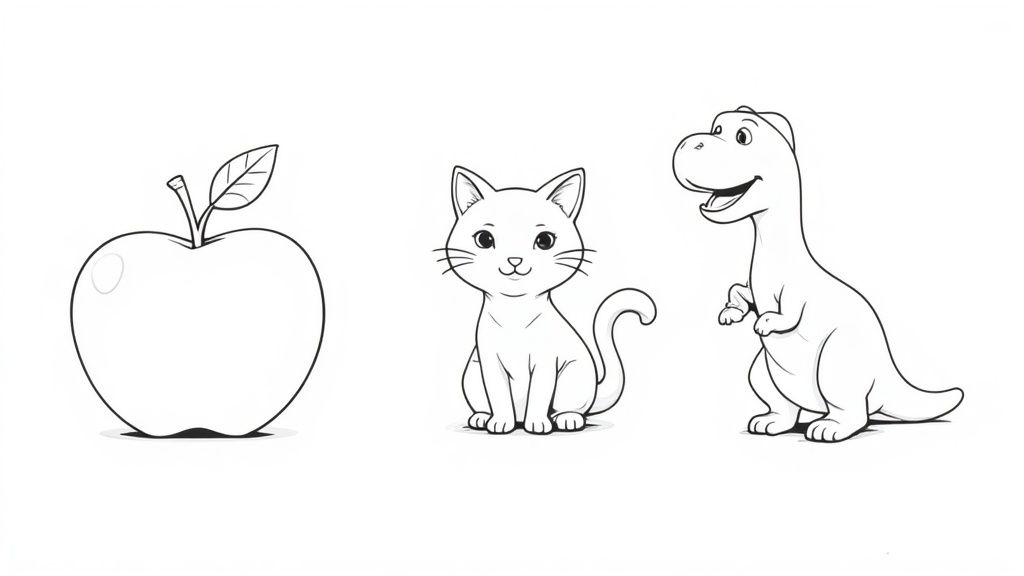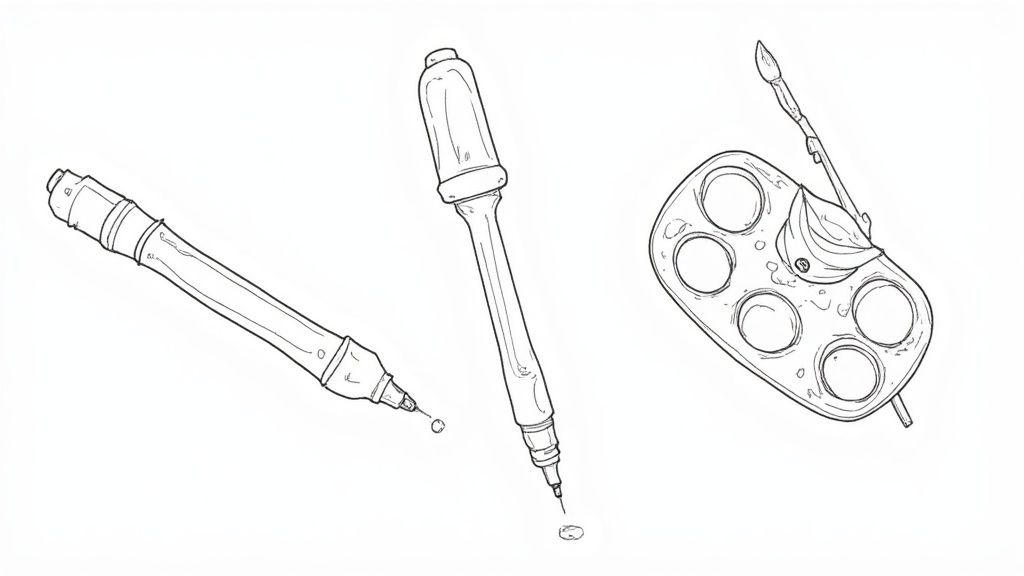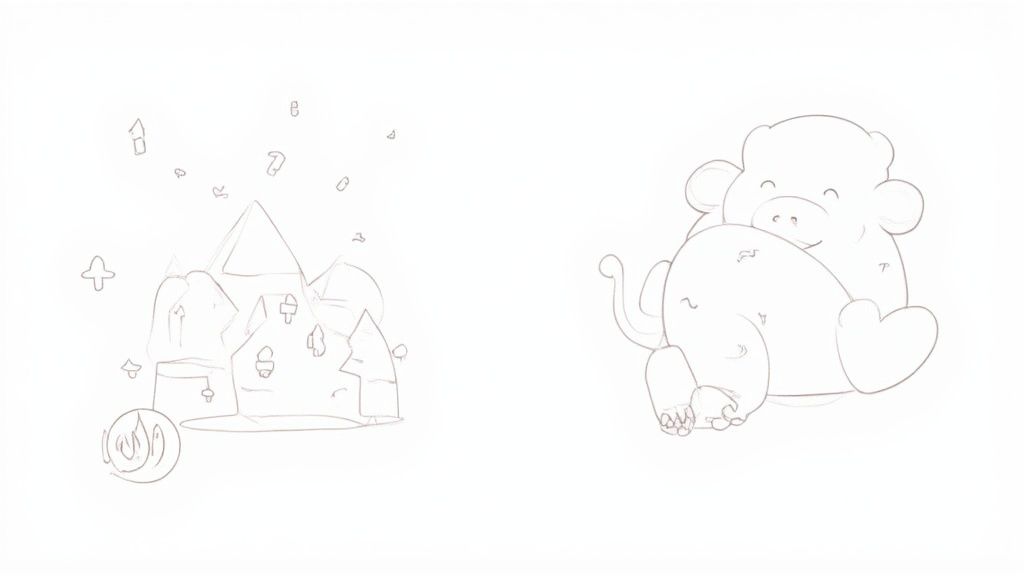It's easy to think of coloring pages as just a simple way to keep preschoolers occupied. But they're so much more than that. This humble activity is actually a powerhouse for building crucial developmental skills. From the fine motor control they'll need for writing to their blossoming creativity, a simple coloring session lays a surprisingly important foundation.
The Hidden Power of a Simple Coloring Page
When a preschooler puts a crayon to paper, it’s not just quiet-time filler. It’s a full-on developmental workout. Every stroke they make and every color they choose helps build the skills they’ll need for school and life, from how to hold a pencil to making their own creative decisions.
Let's reframe this: it’s less about ‘keeping them busy’ and more about ‘building their brain.’ I'm here to show you how to turn that stack of coloring sheets into genuinely meaningful learning moments.
From Scribbles to Skills
The journey from a random scribble to a carefully colored-in picture is a visual map of a child's growth, both physically and mentally. This process helps your little one master key abilities that set them up for success. Even something as small as choosing between a blue or red crayon is an exercise in decision-making and self-expression.
You can actually see how coloring builds these essential skills one after another.

This infographic does a great job of showing the progression. It starts with basic hand-eye coordination, which is the bedrock for developing fine motor skills. Those skills, in turn, open the door to creative problem-solving.
Making Coloring Time Count
The best way to make the most of this activity is to focus on the process, not the final product. Forget about telling them to stay inside the lines. Instead, celebrate their choices. Try saying something like, "Wow, I love that you made the dog purple! That's so imaginative."
My goal is to show you how, with a few simple tweaks, coloring time can become one of the most impactful parts of your child's day.
When you shift the focus like this, you're not just encouraging creativity; you're building confidence. Research has shown that a child's self-esteem is directly tied to these kinds of creative activities. When preschoolers feel proud of what they've made, they start to believe in their own abilities.
Picking the Perfect Coloring Pages for Your Preschooler

Finding the right coloring pages for preschoolers can feel a bit overwhelming with the sheer number of options out there. But the secret to a great coloring session isn't just about finding any picture—it’s about finding the right one for your child's hands and growing mind.
For this age group, simplicity is your best friend. Look for pages with bold, simple outlines of things they can easily recognize. A single big apple, a happy-looking cat, or a basic truck shape are perfect. Steer clear of super busy scenes with tons of tiny details, as those can frustrate a little one before they even get started.
Let Their Interests Lead the Way
What’s the fastest way to get a preschooler excited about coloring? Give them something they already love! If your child is going through a massive dinosaur phase, a T-Rex coloring page will capture their imagination in a way a generic flower pattern never could. This is your magic trick for keeping them happily engaged.
I’ve seen it time and time again—a page with a favorite cartoon character can easily hold a child's attention for twice as long as a random object. It’s all about that built-in emotional connection they already have.
When you match the coloring page to their interests, you're not just giving them an activity; you're validating their world and showing them that their passions matter.
Choosing a beloved theme is a small thing, but it makes a world of difference. It transforms coloring from "something to do" into a truly joyful and creative experience.
Match the Page to Their Developmental Stage
Preschoolers change so quickly. A coloring page that was a perfect fit for a two-year-old might seem boring to a five-year-old. The goal is to build a little collection of pages that can grow with them, offering just the right amount of challenge without being discouraging.
For instance, the youngest preschoolers do best with huge, open spaces to scribble in. As they get a bit older and their fine motor skills sharpen, you can introduce pages with a few more details to keep things interesting. You can explore a great variety of preschool coloring pages printable to find a ton of options for every stage.
It's no surprise that certain themes are always a hit. Animals, for example, consistently top the charts in the world of kids' educational products. Global search trends show that coloring books featuring dogs, cats, and even whales are perennial favorites. You can also find some wonderful themed collections, like the Skout Organic Coloring Book, that offer curated designs.
To make it easier, here’s a quick guide to help you pick the right page based on their age and skill level.
Matching Coloring Pages to Developmental Stages
This simple table can help you quickly identify what to look for when choosing pages for your child.
| Feature | Younger Preschoolers (Ages 2-3) | Older Preschoolers (Ages 4-5) |
|---|---|---|
| Outlines | Thick, bold, and simple lines | Thinner lines with slightly more detail |
| Subject | Single, large, familiar objects (e.g., ball, sun) | Simple scenes with 2-3 objects (e.g., house and tree) |
| Complexity | Very low; large spaces to color | Low to medium; smaller areas to color in |
| Theme | Basic shapes, animals, and common foods | Favorite characters, vehicles, and letters |
Thinking about these small details ensures that coloring time stays fun and helps build their confidence, one masterpiece at a time.
More Than Just Crayons: Creative Coloring Techniques

Once you’ve found the perfect coloring pages for preschoolers, the real fun begins. It's time to think beyond that trusty box of crayons. While crayons are an absolute staple, introducing a variety of tools can transform a simple coloring session into a rich, sensory experience that builds crucial skills.
Different materials challenge a child’s fine motor skills in totally new ways. Switching things up not only keeps them engaged but also helps them discover new textures, vibrant colors, and exciting ways to express themselves. This variety is the secret sauce to fostering a genuine, lifelong love for creating art.
Introduce New Tools and Textures
Moving past wax crayons opens up a whole world of artistic possibility. Each tool offers a unique benefit for your preschooler's developing hands and creative mind. Think about how different grips and movements strengthen the very muscles they'll need for writing down the road.
Consider adding a few of these to your art supply stash:
- Chunky Markers: These are a fantastic starting point for little hands still working on a strong, confident grip. The ink flows so easily, giving them bold, bright colors without much effort—a huge confidence booster!
- Watercolor Paints: Getting out a brush and water introduces the magic of cause and effect. Kids quickly learn that adding more water makes the color lighter, and a wet brush glides differently across the page than a dry one. For a fun twist, show them how to sprinkle a little salt on the wet paint to create a cool, crystallized texture.
- Colored Pencils: These require a bit more pressure and control, making them a great next step for strengthening finger muscles and practicing precision.
- Dot Markers (Bingo Daubers): Speaking from experience, these are a total game-changer. They're practically mess-free and let kids fill in big spaces with satisfying little dots, which is amazing for their hand-eye coordination.
To avoid overwhelming them, try introducing these new options one at a time. This gives your child a chance to really explore what each tool can do. If you're wondering where to start, check out our detailed guide on the best art supplies for kids for some great recommendations.
Guiding Creativity Without Taking Over
Here comes the hard part—learning to guide your little artist without actually directing them. Your job is to be their biggest cheerleader, not their art director. The real goal is to build up their self-esteem and show them that their own creative instincts are what matter most.
Instead of pointing out "mistakes," try celebrating their choices. This simple shift in language can make a massive difference in their confidence. In fact, a staggering 92% of kids report that creative activities help them feel more confident.
Your praise should focus on the process and their effort, not on the finished product's "perfection." It’s about celebrating their journey of creation, which empowers them to keep exploring without fear of making a "mistake."
Here’s how you can reframe your comments to be more supportive and encouraging:
| Instead of Saying This... | Try Saying This... |
|---|---|
| "You went outside the lines." | "I love the big, bold strokes you're using!" |
| "That's not the right color for a tree." | "A purple tree! How wonderfully imaginative!" |
| "You missed a spot." | "Look at all the beautiful colors you've used!" |
This approach teaches a powerful lesson: there is no single right or wrong way to be creative. When you praise their unique vision—whether it's a pink sun or a blue dog—you're telling them that their ideas are valuable. This fosters a sense of ownership over their art and encourages them to experiment even more freely next time.
Turning Coloring into a Learning Adventure

Every coloring page you print is a secret learning opportunity. This is where the real magic happens—turning a simple, fun activity into a powerful educational tool without your preschooler ever feeling like they're being "taught." It's all about the little conversations you have while the crayons are out.
These simple interactions are what transform coloring from a quiet, solitary task into an active, engaging lesson. You’re not just an observer; you're a co-pilot on their creative journey, helping them build important connections in their rapidly developing brain.
Sparking Curiosity with Simple Questions
The easiest way to get started is just by asking questions. Think of yourself as a friendly guide, gently nudging their imagination. Your prompts can open up entire worlds of pretend play, building their vocabulary and critical thinking skills along the way.
Here are a few ways I’ve seen this work with different coloring pages for preschoolers:
- Animal Pages: Instead of just saying, "That's a cow," try asking, "What sound does that big cow make?" or "Where do you think this little monkey lives? In a house like ours or way out in the jungle?"
- Character Pages: Get a story going. Ask things like, "What kind of adventure is this princess on today?" or "Who do you think this superhero is going to meet?"
- Nature Scenes: Connect the page to their real-life experiences. "Hey, we saw a flower just like that at the park! Do you remember what color it was?"
This approach does so much more than just teach them facts. It encourages them to really look, to think, and to link what they see on the page to the world around them.
Weaving in Early Learning Concepts
Beyond just sparking a good chat, you can use coloring time to introduce foundational skills in a completely playful, no-pressure way. Numbers, colors, and shapes are hiding in plain sight on almost any printable. The trick is to keep it light and make it feel like a game.
A page with lots of different shapes, for instance, is a perfect, low-stress intro to basic geometry. You could say, "Let's find all the circles and color them blue!" or "How many triangles can you count on this page?" This simple counting game reinforces number recognition without a single flashcard in sight. You can find more ideas for this in our guide on how to teach kids colors through everyday activities.
These small, teachable moments are incredibly powerful. They seamlessly blend learning with playtime, which is exactly how preschoolers learn best. You're building a positive foundation for concepts like counting and identifying shapes long before they ever see them in a classroom.
Parents clearly value these kinds of engaging, educational materials. The global market for children's picture books—which includes coloring books—is a huge industry, valued at around USD 4.69 billion in 2024 and it's expected to keep growing. This trend really shows how much parents are looking for tools that mix fun with learning. By using these simple conversational techniques, you’re turning every coloring page into a valuable piece of that journey.
What to Do With All That Finished Artwork?
The coloring session is over, the markers are all capped, and you’re holding a vibrant new masterpiece. So, what's next? The way we react to and display our kids' art sends a really powerful message about how much we value their effort and creativity.
Going beyond just slapping it on the fridge can turn a simple drawing into a source of genuine pride for your little one. When we give their creations a real purpose, we're not just decorating; we're building their self-esteem and showing them their work matters.
Give Their Masterpieces a Job
Let's find some fun, practical ways to bring their art into your family's daily life. This simple act shows them that their work has value long after the coloring is done. It subtly teaches them that their efforts can bring joy to others and even serve a real function—a massive confidence booster for a preschooler.
Here are a few ideas to get you started:
- Create Personalized Greeting Cards: Let them pick their favorite colored page. Just fold a piece of construction paper in half and glue their artwork right on the front. Suddenly, they have a beautiful, one-of-a-kind card to give to Grandma or a friend.
- Design Unique Wrapping Paper: The next time a birthday rolls around, use their colorful creations to wrap a small gift. It adds such a personal touch that store-bought paper just can't compete with.
- Make a Custom Bookmark: Snip a long strip from a really vibrant section of a colored page. For extra sturdiness, you can glue it onto some cardstock and maybe even add a little yarn tassel at the top.
Curate a Kid-Friendly Art Gallery at Home
One of my absolute favorite ways to celebrate a preschooler's art is to create a dedicated 'gallery wall' just for them. The trick? Hang the pictures right at their eye level. This small adjustment completely transforms a corner of your home into their personal exhibition space, letting them see and feel proud of their work every single day.
Setting up a special place for their art shows them their creations are an important part of your family's home. It validates their identity as a little artist and encourages them to keep creating without a second thought.
You really don't need fancy frames. String up a line and use clothespins, or try some colorful washi tape directly on the wall. Simple magnetic clips also work great. The goal is to make it super easy to rotate new pieces in. This keeps their little gallery fresh and exciting, celebrating their latest accomplishments while still honoring past favorites. It's a daily, visual reminder that their creative voice is seen, heard, and truly cherished.
Your Questions on Preschooler Coloring Answered
Parents often run into the same little hurdles when coloring with their preschoolers. From a sudden obsession with a single color to frustration over not staying inside the lines, these small challenges are just a normal part of their creative journey. Let's tackle those common questions with some practical, reassuring answers to help you navigate these moments with ease.
The goal here is to give you quick solutions so you can spend less time worrying and more time enjoying this special time with your little one.
What If They Only Use One Color?
It’s a classic scene: you lay out a beautiful rainbow of crayons, and your preschooler reaches for the same brown crayon every single time. While it might seem a little strange to us, this is completely normal behavior.
Often, it's just a phase. They might have simply found a color they love, or maybe they're more focused on the physical act of coloring—the satisfying scribble-scrabble—than the color choice itself.
Here's what you can do: Instead of pushing them to use other colors, lean into their choice. You can say something like, "Wow, you are making that whole dinosaur brown! Is he a muddy dinosaur?" This acknowledges their choice while gently sparking their imagination. You can also offer a variety of shades of that one color, like light brown and dark brown, to slowly expand their palette.
The most important thing is to let them lead. Forcing a variety of colors can quickly turn a fun activity into a stressful one. Their creativity is about their expression, not our expectation of what a picture should look like.
Handling Frustration with Staying in the Lines
The struggle to stay within the lines is a rite of passage for preschoolers. Their fine motor skills are still under construction, and the hand-eye coordination needed for precision is something they are actively learning every day. When they get upset, it’s a sign they're trying hard, and that's something to celebrate.
To help them, focus on building their confidence with these strategies:
- Go for thick, bold outlines. Find coloring pages that give them a bigger buffer, making it much easier to succeed.
- Offer different tools. Dot markers, for example, are fantastic for filling spaces without needing the same kind of control as a crayon.
- Praise the effort, not perfection. Saying, "I love how hard you are working on that part!" shifts the focus from the outcome to their awesome determination.
It's interesting to see how kids' products are evolving. The market for interactive children's books, for example, had a value of USD 660.1 million in 2022 and is projected to hit nearly USD 963 million by 2030. This boom in books that engage kids beyond simple coloring shows just how important sensory engagement and participation are for this age group. You can learn more about the growth of interactive children's books and see how these trends influence playtime.
Of course, creative activities often come with questions about keeping things clean and safe. It's completely normal to wonder about things like a simple guide to cleaning infant toys. Making sure their play environment is healthy is just as important as the fun itself.
Ready to find the perfect coloring pages for preschoolers that will spark your child's imagination? Explore the endless collection at Colortada, where you'll discover hundreds of free, printable pages featuring their favorite characters and themes. Visit us today at https://www.colortada.com and start your next creative adventure.

